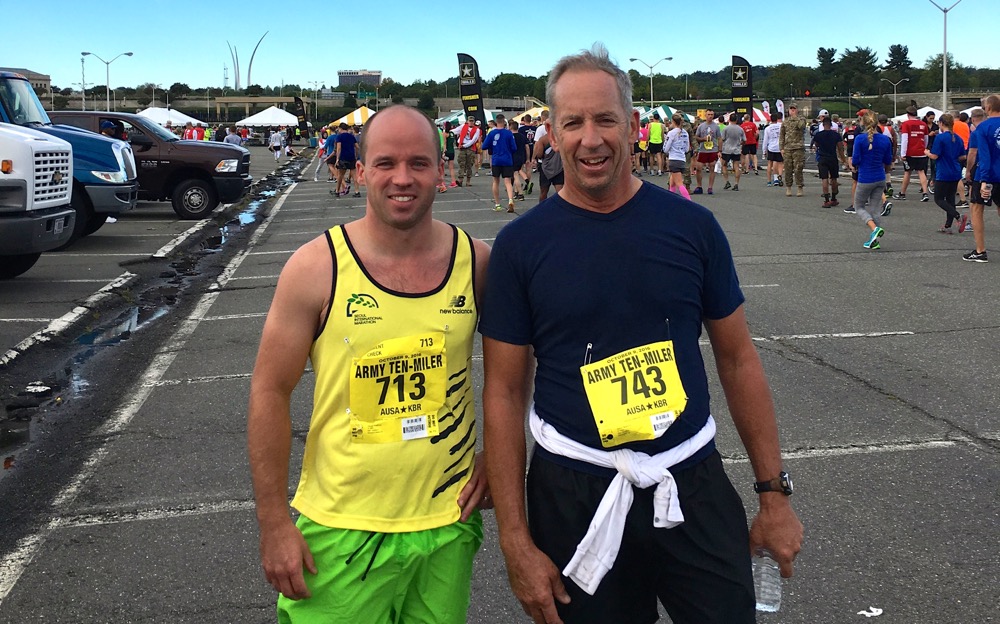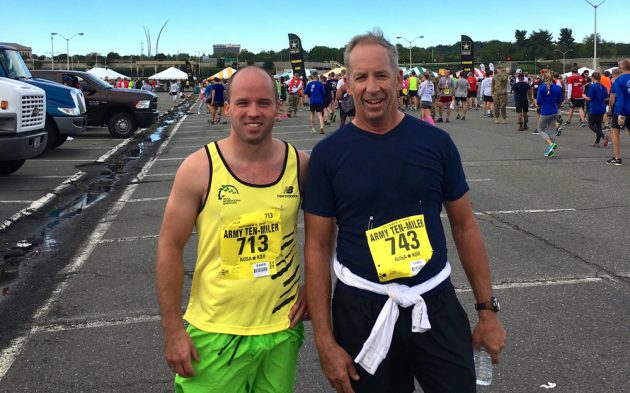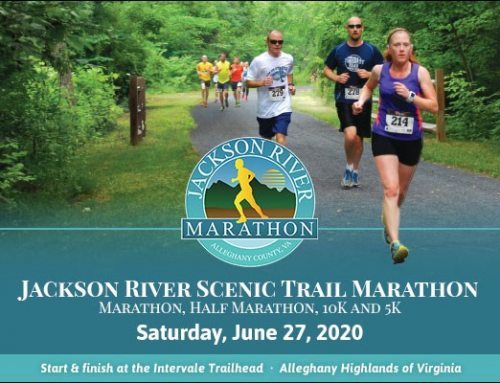By Stephanie Heinatz
The phone calls were few and far between. But I understood. My baby brother was, after all, deployed to Afghanistan as a young Army infantry officer and he had more important women – like Mom – to dial up.
But during those short chats, for at least a minute, we talked about running and training. My promise to him was once he returned home from war, we would run the famed Army 10 Miler through the streets of Washington together.
He’d ask if I’d been training. I’d ask him how many miles he’d logged on the treadmill.
Yes. The treadmill.
While deployed, that young soldier – Capt. Adam Shabbott – was so dedicated to training for this race that he logged more than 1,500 training miles.
On. A. Treadmill.
I shouldn’t have been surprised. Throughout my entire life, I’d watched the best soldier and veteran I know pound the pavement for purposes greater than I understood. Our father – retired Army Sgt. Maj. Joe Shabbott – was an accomplished runner and cyclist. He ran his first marathon after he turned 40 and hung every performance medal and race bib in his office not to brag, but to inspire younger soldiers to bring the same level of dedication and passion to life.
Joe and Adam aren’t alone.
Current, retired and veteran members of the Armed Forces are among the most elite of competitive and amateur endurance athletes.
Fit for duty. Fit for life. That’s the mantra of the U.S. Military Endurance Sports (USMES) program, a division of non-profit American Service Members Amateur Sports, Inc. chartered just to support those very athletes.
But what else motivates these athletes and what keeps them in their endurance sports? Military culture and passion plays a big role.
The Benefits Of Exercise In The Military
It’s not surprising to Paul Reed, PT, DPT that military veterans and active duty service members get and remain active in the endurance sport community.
“The culture of sports and fitness in the military environment is strong,” said Reed, a military veteran, endurance athlete himself. He started out as a Navy Seabee who drove tugboats and now serves as the Clinical Director of the Tidewater Physical Therapy First Colonial location in Virginia Beach.
“Physical fitness is a key component to a military person,” Reed said. “It’s vital to their job. You have to have an ability to run, handle heavy loads, carrying things on your back. Fitness is so well regarded and important in the military that it’s built into the job with PT – physical training, not physical therapy – built into every single day of the work week.”
Plus, exercise is accepted and promoted.
“It you have downtime in the military, exercising was a way to occupy your time,” Reed said. “At Little Creek, where I was stationed, they have a very excellent recreation center and we were always doing some type of exercise.”
The Centers for Disease Control and Prevention recommends most people complete two hours and thirty minutes of exercise a week. That breaks down to 30 minutes 5 days a week a – which the military builds in as a requirement.
In many ways, the military has been ahead of the game. Today, Reed said, more and more employers in the civilian world are recognizing the importance of encouraging physical fitness with their teams and are bringing in physical therapists and personal training to offer employee workout options during the week.
They’ve realized what the military knew long ago, Reed said, and that’s that “exercise improves health, morale and team building.”
Road To Running
Joe Shabbott enlisted in the Army in the summer of 1977. Living in a small, rural town of New Hampshire at the time, the Army offered opportunity and money for college.
He wasn’t an endurance athlete then, although he grew up playing ice hockey and there was “always a fair amount of running involved.”
His journey to endurance sport was a two-step process that came decades later.
It was 1998. Forty was closing in fast.
“And I took the step from doing normal Army PT-level running up to intermediate distances, like 10 milers,” Shabbott said.
Then 40 arrived “and it was either marathon running or buy an expensive sports car. I ran my first marathon when I was 40. It was a mid-life crisis to test myself to see if I could still do something like that.”
Nearly at the same time, Shabbott saw a need to motivate his soldiers to do better, reach further.
He wanted to show, not tell, how to go above and beyond.
“I started hanging my race bibs and performance medals on the wall of my office,” Shabbott said.
“The culture and the lifestyle in the Army very positively influences fitness,” Shabbott said. “There are minimalists that will do just what is required. But there are also those that it leads to endurance sport.”
The Mindset Of An Endurance Athlete
Endurance athletes, much like military members, are a unique bunch, Reed said.
They’re dedicated.
“It takes raw, powerful dedication to stick to a six month training program,” Reed said.
They’re passionate in ways many can’t understand.
“And they are competitive, over achievers, obsessed and sometimes compulsive,” Reed said, all in a good way.
“I’ve learned through my own training and working with endurance athletes that above anything else, they are dedicated fitness people,” said Reed, who’s striving to qualify for the elite Boston Marathon.
But not all of them would call themselves endurance athletes.
“We’ve been trying to figure out and define the word endurance,” Reed said. “It’s not just someone who runs or rides a bike or runs, bikes and swims. What we’ve decided on, and by we I mean the community I’m involved in, is that it varies from individual to individual.”
In large part, the endurance athlete trains a lot. We’re talking nine to 12 hours a week. Cycling events can be three and four hours in length. They’re working up to ultra events, like a century (100 miles on a bike) or a marathon or 50K.
And they want to keep training and running, cycling, swimming or a combination of all three as long as possible.
Keeping Endurance Athletes Competitive
Endurance athletes will chronically train hurt. Not injured. But hurt.
“To admit an injury as an endurance athlete or to show an injury is to show a sign of weakness,” Reed said. “This group, like the military, is extremely competitive. They want to win at everything and they don’t like coming in for medical health prevention. Preventative therapies are a tough sell to this group.”
Active recovery is easier to explain the benefits of. Reed aims to teach more endurance athletes, and endurance veteran athletes, active recovery techniques.
“They need some type of activity that will allow them to recover,” Reed said. “When you train, you stimulate your sympathetic nervous system. You heard of fight or flight? Sympathetic is the fight system. Athletes need to turn that off and engage the parasympathetic nervous system. The flight.”
That is what allows athletes to heal, Reed said.
“Gentle swimming, yoga, foam rolling, massage,” Reed said. “All of these are great active recovery options for an endurance athlete.”
The Endurance Journey
Since his first running days, Joe Shabbott has completed 12 marathons – including the Boston Marathon – and numerous other smaller races, from half marathons to 5Ks. He stopped counting after awhile because it was about the sport of it all, not the number of races.
Eventually, he transitioned from running to cycling because of an injury.
“It wasn’t overuse or anything,” Shabbott said. “It was a direct trauma hit. The dog ran into me while playing Frisbee and tore my meniscus.”
Shabbott continued running on that knee for years after – last marathon was the Air Force Marathon in 2006 – until some knee pain started creeping in and an introduction to endurance level cycling pulled him onto a bike.
Now he logs more than 5,000 miles a year on that bike.
And every now and then, he still pins on a race bib and pounds the pavement, running alongside his son (my brother).
# # #
Stephanie Heinatz is a professional writer and founder of Consociate Media. She started her writing career as a newspaper reporter covering the military and spent time reporting on military issues in Hampton Roads, Virginia. She was an embedded reporter during the Iraq war and reported on special assignment in East Africa.








